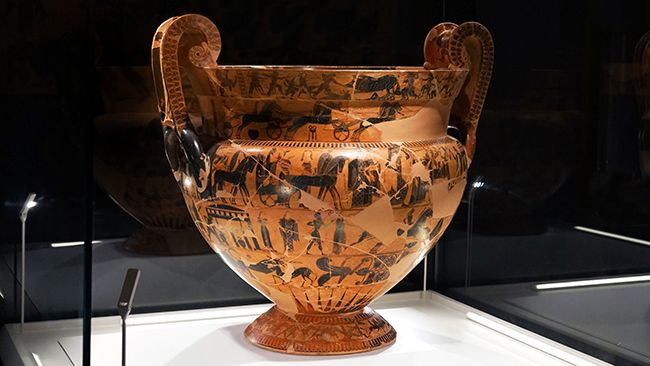Is Ceramic And Pottery The Same Thing?
Ceramics and pottery are often used interchangeably in everyday language, but they actually refer to distinctly different things. Ceramics is a broad category encompassing many types of art made from clay and ceramic materials. Pottery refers specifically to functional clay vessels like cups, bowls, and vases. While all pottery is ceramic, not all ceramic is pottery. There are important distinctions between the two in terms of history, material, uses, and artistic style. Understanding the relationship between ceramics and pottery provides valuable insight into human creativity and innovation across cultures and time periods.
Define Ceramic
Ceramic refers to any product made from a non-metallic mineral by applying heat. The word “ceramic” comes from the Greek word “keramos,” meaning potter’s clay or pottery. Ceramics are primarily made of clay – a naturally occurring material found all over the world that can be shaped when wet, dried, and then fired at high temperatures to permanently harden it (Wikipedia, 2022).
Ceramics are generally brittle, hard, strong in compression, weak in shearing and tension, and withstand chemical erosion that occurs in other materials subjected to acidic or caustic environments. Because of these properties, ceramic materials hold wide applications in domestic, industrial and building products (Merriam-Webster, 2023).
Types of Ceramic Materials
Ceramics are composed of inorganic, non-metallic materials that are subjected to high temperatures during manufacture or use. The most common ceramic materials include clay minerals, silica from sand, and feldspar.
Clay is a very common ceramic material that is composed of hydrated aluminum silicates. The different types of clay used in ceramics include kaolin, ball clay, and bentonite. Clays are molded and shaped when wet, hardened by drying, and then fired at high temperatures in a kiln. The firing process changes the clay’s molecular structure, driving off water and strengthening the material.
Silica is one of the most abundant materials on earth and is a major component of sand. In ceramic manufacturing, the silica is mixed with clay to provide mechanical strength and improve workability. Silica is an essential ingredient in materials like earthenware, stoneware, and porcelain. [1]
Feldspar is the name given to a group of minerals that contain alumina and silica. In ceramics, feldspar acts as a flux during firing which lowers the vitrifying temperature of the material. Feldspar also improves the strength, toughness, and durability of the fired ceramic body. [2]
Kaolin is a type of clay rich in the mineral kaolinite. It is white in color and has a fine particle size and plasticity that make it ideal for manufacturing porcelain and china. The name itself derives from the Chinese town of Gaoling. Kaolin clay requires firing at higher temperatures than other clays but results in a very pure white ceramic. [3]
Define Pottery
Pottery refers specifically to ceramic material that is made into potteryware like vases, plates, bowls, and other objects.1 The term pottery also refers to the art or craft of the potter or the manufacture of pottery.2 Pottery is made by forming a ceramic body into objects of a required shape and heating them to high temperatures in a kiln to induce reactions that lead to permanent changes.3 Clay bodies at different stages in the manufacturing process are sometimes called clay wares or green wares.1
Pottery is a Type of Ceramic

Pottery is a specific type of ceramic that is made from clays and fired at high temperatures to harden it. While ceramics encompasses a wide range of materials including glass, cement, and carbon, pottery refers specifically to objects made from clay.
The key distinction is that pottery focuses on making vessels, containers, plates, mugs and other functional or decorative objects out of clay. Ceramics, on the other hand, has a much broader definition that includes clay pottery but also extends to other non-clay materials.
So in summary, pottery is a subclass of ceramics that involves shaping clay into objects and firing them. All pottery is ceramic, but not all ceramics are pottery. Pottery utilizes clay while ceramics can use other inorganic materials.
As explained by Soul Ceramics, “A piece of pottery is usually something that is made as a functional piece” whereas ceramics encompasses both functional and non-functional materials including clay, glass, concrete, enamel, and more.
Sources:
https://www.soulceramics.com/pages/ceramics-pottery-difference
https://www.classpop.com/magazine/ceramics-vs-pottery
Manufacturing Process
The manufacturing process for ceramics and pottery differs in a few key ways:
Ceramics are made from non-metallic minerals like clay that are fired at high temperatures. The raw materials are refined and shaped using industrial techniques and processes before firing. Ceramics can be glazed or left unglazed. Some common manufacturing methods for ceramics include slip casting, tape casting, injection molding, and dry pressing. [1]
Pottery, on the other hand, is made from clay and formed entirely by hand or using a potter’s wheel. The clay is wedged and kneaded to remove air bubbles and blended to achieve the right consistency. Pottery pieces are shaped using hands-on techniques like throwing, coiling, pinching, or slab construction. Pottery can be decorated using hand painting, carving, or stamping. After forming and decorating, pottery is usually fired in a kiln at lower temperatures than ceramics. [2]
The main differences are that ceramics utilize industrial techniques and high firing temperatures, while pottery is shaped by hand at lower temperatures. Ceramics production tends to be more precise and standardized due to automation, whereas pottery retains more handcrafted character.
Uses
Ceramics have a broad range of uses beyond just potteryware. Some common applications include:
– Building materials like bricks, tiles, and cement (1). Ceramic materials like clay bricks and concrete are used in construction because they are durable, fire-resistant, and weather-resistant.
– Industrial tools and parts such as pipes, thermocouple protection sheaths, and ball bearings (2). Ceramics are valued for their hardness, strength, and ability to withstand high temperatures in industrial processes.
– Consumer products like dinnerware, sanitaryware, decorative objects, and jewelry. The aesthetics, durability, and ease-of-shaping make ceramics ideal for crafting these household goods.
– High tech electronics and medical implants (2). Advanced ceramics like alumina and zirconia have excellent electrical insulation and biocompatibility for these applications.
– Ceramic composites are also used for thermal protection systems in spacecraft (2). The heat resistance allows ceramics to protect the spacecraft from burning up during re-entry.
Artistic Differences
There are some key artistic differences between pottery and ceramic artwork. While both pottery and ceramic objects can have artistic merit, pottery often has more of an artistic focus while ceramics may be more functional or industrial in nature.
Pottery is often thought of as an art form, involving the skillful shaping of clay into artistic or decorative objects like vases, plates, bowls, and figurines. Pottery can showcase artistic techniques like hand-building, throwing, slip trailing, glazing, and firing. Many pottery pieces are one-of-a-kind artworks meant for display rather than utilitarian use. Famous pottery styles include Italian majolica, Chinese porcelain, and Southwestern Native American pottery.
In contrast, ceramics may refer more broadly to industrial objects like bricks, tiles, countertops, and bathtubs that, while aesthetically pleasing, are mass-produced and valued for strength, durability, and heat resistance. However, there is overlap as many decorative ceramic pieces bridge the line between art and function. Overall, while ceramics have practical uses, pottery emphasizes artistry, creativity, and design.
Cultural Significance
Pottery has a rich history and continued cultural importance around the world. Evidence of pottery production dates back 20,000 years, making it one of the oldest human technologies. Across cultures and eras, pottery has served essential practical functions like storing, transporting, and cooking food. However, it has also expressed cultural values, identities, and beliefs. The styles and decoration of pottery evolved across different civilizations and reflected local customs and lifestyles.
Many cultures integrated pottery into rituals and ceremonies. Native American tribes used symbolic imagery on pots for spiritual purposes. Ancient Greek pottery depicted scenes from myths, battles, and everyday life. Chinese porcelain sometimes featured traditional motifs like dragons. Pottery unearthed by archaeologists provides insights into past societies. The chemistry and origins of clay indicate trade networks. Vessel shapes mirror innovations like bronze casting. Decoration styles point to outside influences blended with local techniques.
Even as materials have advanced, pottery persists as an artform. Traditional methods are still practiced around the world and tied to cultural heritage. However, contemporary ceramic artists also push boundaries and fuse ancient techniques with modern forms. The universal appeal and accessibility of shaping clay keeps pottery a vital means of human creative expression.
Sources:
https://thepotterywheel.com/why-is-pottery-important/
https://www.linkedin.com/pulse/art-significance-pottery-sridevi-venkateshwararao
Conclusion
In summary, while ceramic and pottery are closely related terms, there are some key differences. Ceramic is a broad category that encompasses all objects made from clay that are fired at high temperatures. This includes utilitarian and decorative objects like tiles, dishes, vases, and sculptures. Pottery is a type of ceramic, specifically referring to objects made of clay that are intended for practical use, such as pots, plates, cups, and bowls.
While ceramics can be made purely for artistic expression, pottery tends to emphasize function and utility in its design. Ceramics utilize a wider array of materials and firing methods, whereas pottery relies on just a few specific clays and techniques ideal for vessels and containers. Yet both require knowledge of working with clay, glazing, and kilns to produce a finished product.
In the end, pottery falls under the wider ceramics umbrella as a specific application of ceramic materials and methods. But the terms highlight the sometimes overlapping yet distinct nature of functional pottery vessels versus decorative ceramic arts.


